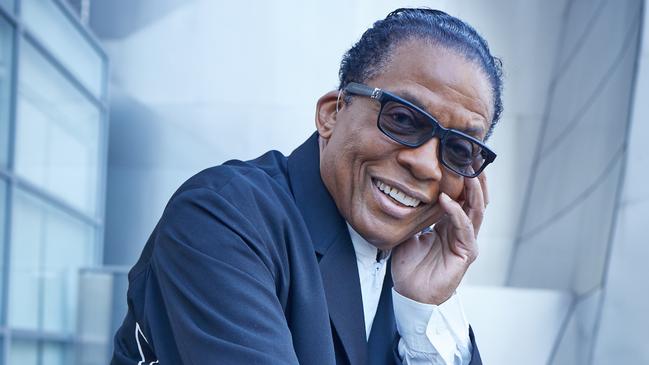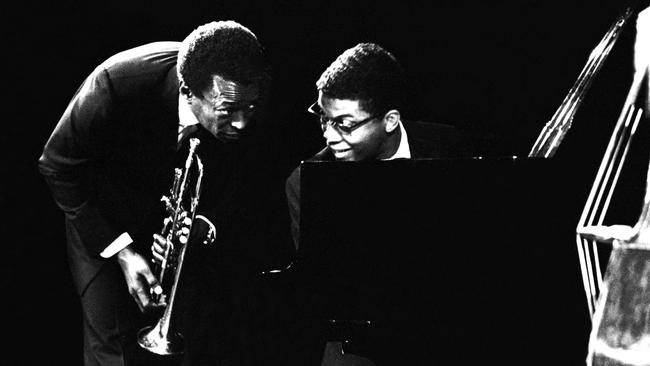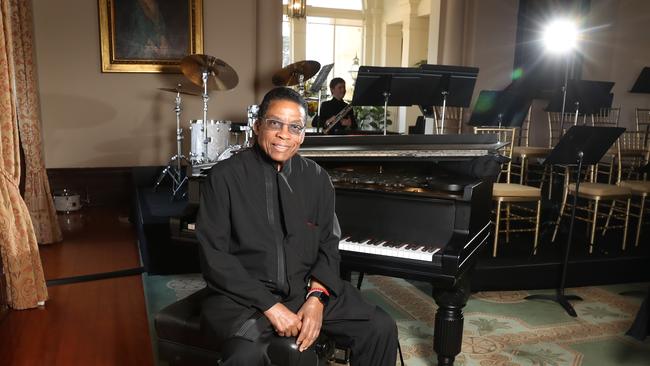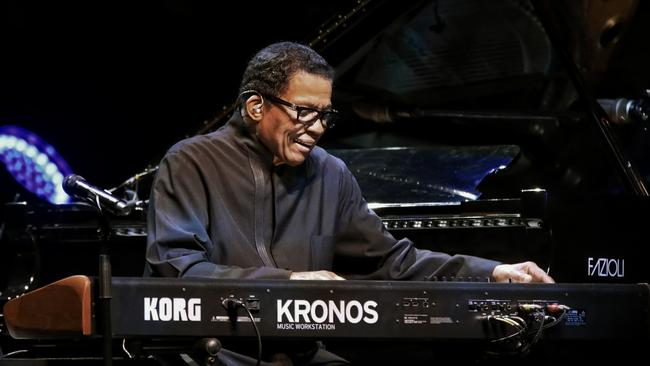Jazz pianist Herbie Hancock is ready to take on Australia
Jazz is the secret to a better world and AI is overwhelmingly positive if used correctly, says the self-confessed technology geek, Nichiren Buddhist, Oscar winner and bona fide music legend.

There is freedom in jazz,” says Herbie Hancock, 84, a living legend of the form. “Jazz lets you dare to step off a cliff with your ideas, while also playing with musicians who are listening and responding to what you are doing, knowing that their job is to do whatever it takes to make the music blossom.”
At home in West Hollywood, wearing black-framed glasses, a blue diamond-patterned shirt and a watch with a bright red wristband, Hancock flashes a smile. “That is the character of jazz,” says the 14-time Grammy-winning pianist and keyboard player. After a seven-decade career as an innovator, collaborator and solo artist, he should know.
Back in the mid-1960s Miles Davis taught Hancock, mid-concert, that there is no such thing as a wrong chord, a bum note. Then 22, Hancock had joined Davis’s Second Great Quintet after a stint of session work with trumpet player Donald Byrd, a mentor who had helped implement Hancock’s signing to the renowned Blue Note label and his subsequent hard-bopping 1963 debut, Takin’ Off. Midway through the quintet’s European tour, Hancock made a rookie mistake, or so he thought – until Davis caught the pianist’s wayward harmonic in a net of improvised notes, deftly rerouting the flow.
“Miles loved being thrown a curve ball,” says Hancock of Davis, with whom he worked for five years alongside fellow young jazz guns, bassist Ron Carter, tenor saxophonist Wayne Shorter and drummer Tony Williams. Davis had recognised Hancock’s genius (“Herbie was the step after Bud Powell and Thelonious Monk, and I haven’t found anybody who has come after him,” he wrote) and encouraged his use of electronic instruments, particularly the Rhodes piano that so elevates 1969’s A Silent Way.
A self-confessed geek with a major in electrical engineering, Hancock has used synthesisers and new audio technologies to blaze a trail through modern music.
He already had a hit with Watermelon Man – inspired by the rhythm of watermelon sellers’ carts on cobblestones in Chicago, where he was a working-class child prodigy who played with the Chicago Symphony aged 11 – and drawn acclaim for the classics Maiden Voyage and Cantaloupe Island when he took his fuzz-wah pedalled electric piano and formed Mwandishi. The sextet’s name meant “composer” in Swahili and their sound was spacey, intuitive, Afro-futuristic, informed as much by John Coltrane’s questing spirituality as James Brown’s “Say it loud, I’m black and I’m proud” defiance.

Funk was always a thing. “Funkiness comes from the African-American heritage,” Hancock says. His epochal jazz-funk outfit, The Headhunters, burst on to the scene in 1973 with an eponymous album boasting a Sly Stone-esque lead single, “Chameleon”, and an album cover collage that saw Hancock wearing a traditional Ivory Coast mask customised with radio knobs for eyes and a VU meter (an electronic device for measuring loudness) for a mouth. Ten years later The Headhunters made a foray into hip-hop with Rockit, the scratch-driven hit that made Hancock a pop star.
“Jazz is a big canvas to explore and I like mixing everything together,” says Hancock in the softly stern, firmly avuncular way of the longtime A-lister. “I want to keep looking forward, staying open, which is why I’m always working with young people. They are the future.”
Hancock will be navigating the line between innovation and commerce when he visits Australia in October, accompanied by an all-star quartet including trumpeter Terence Blanchard and Lionel Loueke on guitar and vocals. He is midway through an extensive US tour, having just wowed the Hollywood Bowl with a two-part bill that saw him and the three original Headhunters joined by Grammy-winning bass guitar icon (and fellow Miles Davis collaborator) Marcus Miller – who is appearing in a double bill with Hancock at the Melbourne Bowl as part of Melbourne Jazz Festival.
I tell him I’ve just seen Miller play the intimate Ronnie Scott’s jazz club in central London, on the same night Loueke was co-headlining (with jazz singer Gretchen Parlato) a mid-sized gig nearby. Does he miss playing smaller spaces? He pauses. “When was the last time I played a club?” he ponders, letting the question hang. “Now I only play concert halls. I don’t go to wherever the scene is after midnight. I don’t even sit in anymore. I’m not getting any younger, so I got to take care of myself.”
Hancock’s career has been a masterclass in quality, versatility and, indeed, creative energy. He has variously scored films including 1986’s Round Midnight, for which he won an Oscar (and in which he appeared as an actor); enjoyed a collaborative partnership with Gambian kora maestro Foday Musa Suso; crafted such Grammy-winning albums as 1998’s Gershwin’s World (with Chick Corea, Wayne Shorter and Stevie Wonder), the 2007 tribute River: The Joni Letters (featuring Loueke, Shorter and Mitchell herself), and; 2010’s The Imagine Project, a work themed to promote global understanding and recorded across seven countries with the likes of Pink, Jeff Beck and sitarist Anoushka Shankar.
Promoting peace and understanding has long been a priority. Designated a UNESCO Goodwill Ambassador for intercultural dialogue in 2011, Hancock has been a Nichiren Buddhist at Soka Gakkai International for 53 years, walking the talk, and chanting for up to an hour each day.
“You practice for yourself but also for others,” he says of a faith that has accompanied most of his 56-year marriage to his wife, Gigi, with whom he has a daughter, and arguably buoyed him through such difficult challenges as the death of his sister in a plane crash in 1985, and his own brief addiction to hard drugs in the 1990s.
“(Nichiren Buddhism) has some amazing concepts,” he continues animatedly. “For example, every human is important and irreplaceable because each of us has a mission that’s ours alone. It’s through the process of chanting the sound-based meditation nam-myoho-renge-ko” – he rolls the words into each other – “and attending meetings where we elevate each other, that we find it.”

What, then, does Hancock consider his mission? Is it heading up the Herbie Hancock Institute of Jazz Performance (formerly Thelonious Monk Institute of Jazz), a non-profit music education organisation that facilitates free jazz education in public schools throughout the US and the world? (On his last 2019 visit to Australia Hancock led a masterclass at the Sydney Opera House with mostly teenage music students.) Is it to finally get around to finishing his long-awaited new album, his first since The Imagine Project, a work mooted to feature rapper Kendrick Lamar, saxophonist Kamasi Washington and producer/multi-instrumentalist Terrace Martin?
“I haven’t been doing anything with that lately because I’ve had to concentrate on public appearances and doing interviews,” he says. “But as a matter of fact, Terrace was over here a few days ago with new material he’s been working on with these young producers he’s training. It’s genius stuff.”
Having worked with everyone from Blue Note founder Albert Lion to leftfield bassist Bill Laswell and, repeatedly, the commercially minded David Rubinson, does Hancock have a favourite producer?
“I don’t think that way,” he says, just mildly stern. “I don’t think higher up. I look at myself in a very different way than I used to. I’d always thought of myself as a musician until one day, chanting and thinking about my life, family and career, I had an epiphany. I was a husband, father, son, brother, friend and neighbour, and what connects all those things isn’t music but the fact I am a human being.
“That clarity changed my life. Consequently, I believe that no matter whether you’re a scientist at NASA or a person coming to take out the garbage, we are all deserving of the same respect.”
In 2016 Hancock was recruited by NASA to join a project focused on making music from tones and overtones collected by the Juno spacecraft as it orbited Jupiter. “But other people got involved and it changed hands, and my input was never in the final product. I did go down to NASA and watch on their screens as they sent a probe to Jupiter.” A smile. “Me and all the geeks.”
Unsurprisingly for one in the vanguard of technological advances in music, whether Fender, vocoder or the trusty white keytar he likes to strap on mid-set, inviting the crowd to holler back his noodlings, challenging them to handle a “wrong” note, Hancock is all for the use of artificial intelligence.

“Yes!” He pumps his fist. “AI is a new kind of being. Soon there will be robots, humanoids, but now they are like teenagers. We gave birth to them so we must help raise them, implementing guidelines to prevent us from putting ourselves in harm’s way and laws to protect us from those who would sacrifice humanity for profit. It all has to be done carefully so not to impede progress.”
Emerging technologies are overwhelmingly positive if used correctly, says the man who bought his first computer “early in the game” in 1979 (an Apple II Plus with 48K of RAM), then spent the next few years encouraging every musician he met to learn how computers worked. “I knew how important computers would be in music. And you know, now I have Alexa. I have a Siri on my iPhone …”
Laughing, he puts up a hand to his ear. “I’m wearing a hearing aid and Siri just answered me.”
In the end – or in the future – it all comes back to the character of jazz. “People are afraid of AI, like they were of computers,” he says. “But what about our own species? The world is in trouble. We need to become better, kinder people. If we do the things that jazz demonstrates – where even if you don’t like another player your job is to lift everything up – we can move forward in a way we can be proud of. Let’s think about the greater good of humanity.”
Hancock smiles. “Let’s start there.”
Herbie Hancock headlines Melbourne International Jazz Festival, which runs from October 18-27; Hancock also plays Sydney, Canberra, Perth, Brisbane and Adelaide.




To join the conversation, please log in. Don't have an account? Register
Join the conversation, you are commenting as Logout